Division is a superpower that breaks down a whole — whether you’re cutting a pizza or divvying up playing cards!

Author
Christina Levandowski

Expert Reviewer
Jill Padfield
Published: August 24, 2023


Division is a superpower that breaks down a whole — whether you’re cutting a pizza or divvying up playing cards!

Author
Christina Levandowski

Expert Reviewer
Jill Padfield
Published: August 24, 2023




Division is a superpower that breaks down a whole — whether you’re cutting a pizza or divvying up playing cards!

Author
Christina Levandowski

Expert reviewer
Jill Padfield


Key takeaways
Division is one of the most important maths skills you’ll learn, helping you to undo multiplication problems or break off parts of a ‘whole’.
We know it looks complicated, but it really isn’t! You just need to know what signs to look for that tell you when division is needed.
Like addition and subtraction, division uses a few special terms and symbols. Knowing these can help you to work out your problems quickly and correctly.
With a little practice and this handy guide, you’ll be flying through your maths homework in no time! Let’s get started.
Unlock unlimited maths questions
Put your learning into practice with fun exercises + games that are proven to boost ability!
Get 2 FREE weeks of Doodle!
Use code AUTUMN_2025 to enjoy unlimited questions and games
Get 1 FREE month of Doodle!
Use code MONTH_2026 to enjoy unlimited questions and games
Division is a process in maths that lets you break down a number into multiple, equal parts.
Sometimes, you can cut everything down into whole number parts, and sometimes you’ll be left with a little leftover, giving you a decimal or fraction for an answer rather than a whole number.
You’ll often see division problems vertically, like this:
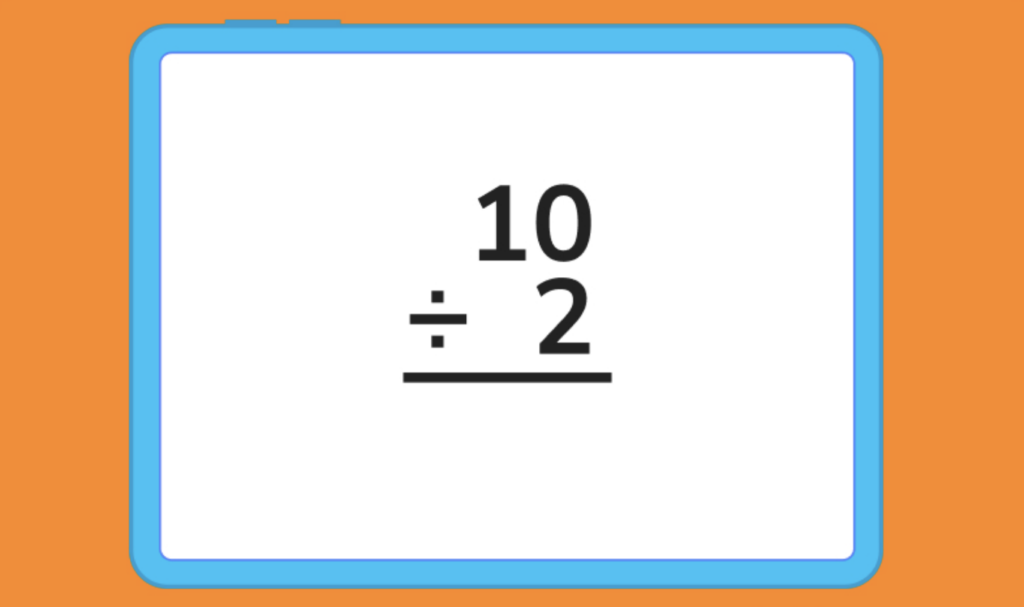
It can also be written horizontally: 10 ÷ 2, as 10/2 , or using a division bar: 2 ⟌ 10.
No matter how you see it, though, the use for it is always the same. You’re breaking down a number or quantity into smaller pieces.
Let’s take a look at some key terms that’ll help you build your division skills.
Division is a simple mathematical operation, but there are still a few terms to know to help you find the correct solution.
Here are the terms you need to know to solve division equations with ease:
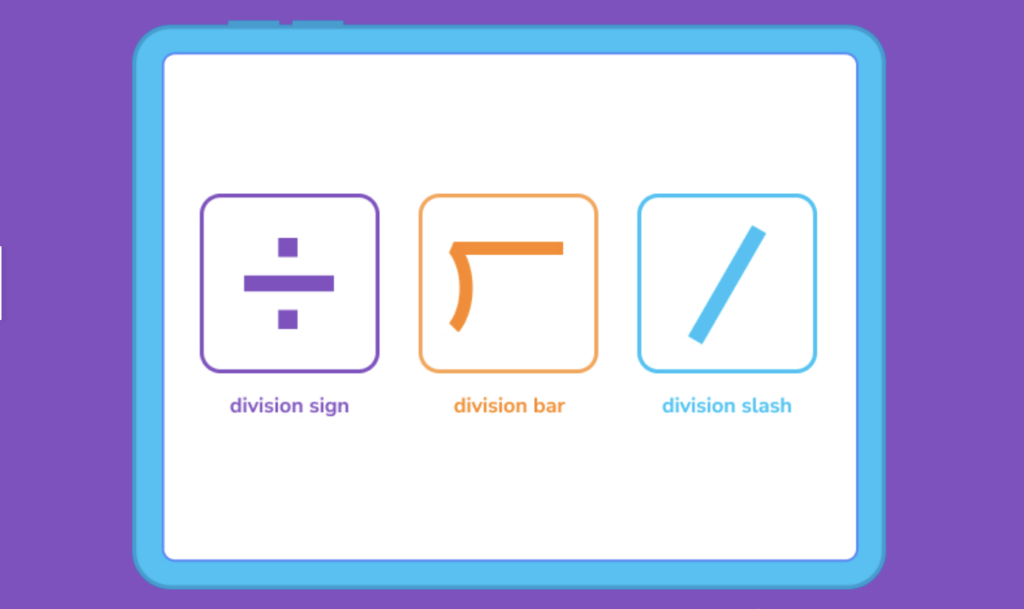
➗ — This is known as a division sign, and it tells you that a number needs to be broken down into multiple pieces.
⟌ — This is the division bar, and it also means to divide. On the outside of the bar, you’ll see the number determining how many pieces are needed from the whole (the divisor), and the dividend on the inside, which is what you’ll be dividing. The answer goes on the top of the bar.
∕ — This is known as the division slash. Generally, the divisor comes first, and the dividend will appear second.
Knowing these terms will help you to know what numbers you’re dividing and how you should set up and read your equations. There are four main terms to know as you work through your arithmetic operations.
DoodleMaths is an award-winning app that’s filled with thousands of questions and games exploring multiplication, division and more!
Designed by teachers, it creates each child a unique work programme tailored to their needs, doubling their progression with just 10 minutes of use a day.* Try it for free!

*Based on earning 24 stars a day in DoodleMaths. Read full study
Anytime you see the word ‘property’ in maths, know that it’s just a rule to remember as you work through your groups of problems. Here are some of the most important properties of division that you need to know:
Knowing these helpful properties can help you to do basic operations (like division) confidently. Remember — these are division facts, so these properties will always be true…no matter what problem you’re working to find the quotient to!
Now that you know the terms and properties of your division operation, it’s time to practice your skills. Let’s work the problem below together.
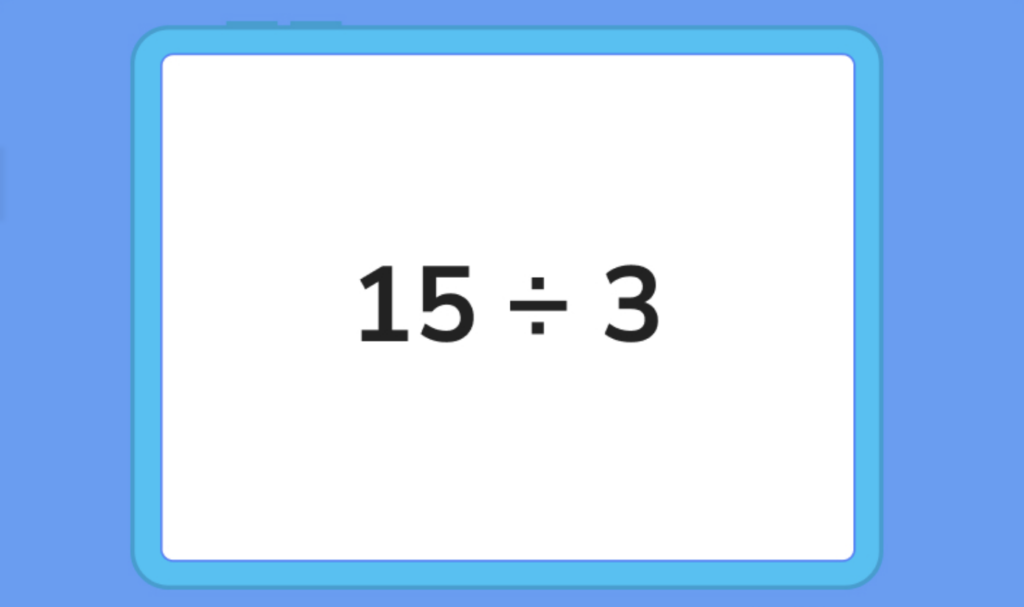
We know that the problem above can feel overwhelming — so we want to take this moment to remind you that what we’re doing is breaking down a number into smaller numbers (or smaller groups of numbers).
First things first, we have to prepare the equation. Feel free to keep it horizontal, write it vertically, or use a division bar if you’d like. Use whatever method you feel comfortable with.
Remember: The dividend (15) belongs inside the division bar if you choose to use that method.
As we begin to divide, we need to start from the first digit from the left (in this case, 1) and ask ourselves: Does the divisor (3) go into 1 at least once?
The answer here is “no,” so we will then evaluate the first AND second integer (making 15) as a dividend.
We ask again: Does the divisor (3) go into 15 at least once?
Now, the answer is “yes” — we just have to count how many times 3 can go into 15, starting our division process.*
NOTE: You can do this by using basic arithmetic operations (such as multiplication) to ‘undo’ the problem (i.e., 3 x ? = 15) or counting by threes until you reach 15.
In our case, 3 goes into 15 a total of five times.
Now that we know that 15 ÷ 3 = 5, it’s time to write it into our equation. Go ahead and write 5 behind the equals sign or standing tall at the top of your division bar.
Now, we have to check our work. We have to ask ourselves: what is 5 x 3? Does it equal our dividend? If it does, you’re golden — you’ve done it!
Do the multiplication, and then subtract your product to ensure that there’s no other steps remaining (like you’d see in the case of a remainder).
In our example, 15 – 15 = 0…so no remainder or further action is needed.
In other problems, if you did have a three or four digit dividend, you might need to bring down the next digit in the dividend, and determine if your divisor divides that number cleanly.
You would then repeat the division process, putting your answer over the third or “next” place above the division bar as part of the quotient.
Next, yo would repeat step 4 to determine if more steps in the division process are needed.
In our example, we don’t have to do this, so we will leave it as is. Good work!
Congratulations! You just broke a large number down into equal, separate parts. It’s time to repeat the process for your other problems.
Long division is a form of division that’s used to break down larger numbers and will generally repeat steps 1-6 above at least three or more times.
We’ll work on that stuff later — for now, let’s just focus on mastering the basics!
What happens when you wind up with a little extra left over, you might ask? While it can look pretty scary, it’s simple to solve.
To do this, you’ll repeat steps one through five above until you get a number that cannot continue to be divided evenly. At this point, you’ll do a few additional steps:
When you see that there’s zero left over, or if there is no way for the divisor to divide into the dividend, that means that your problem is solved!
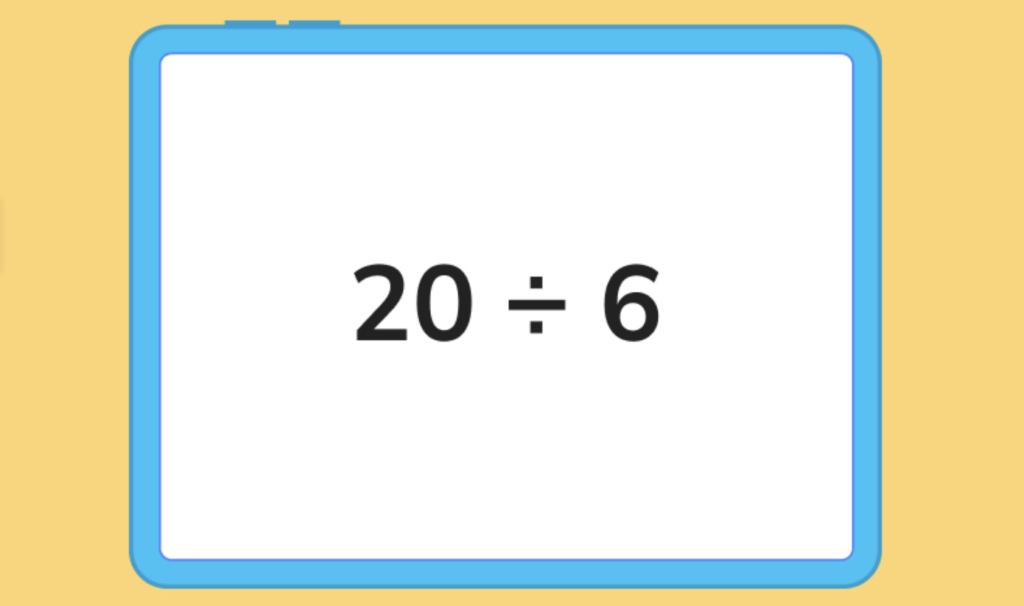
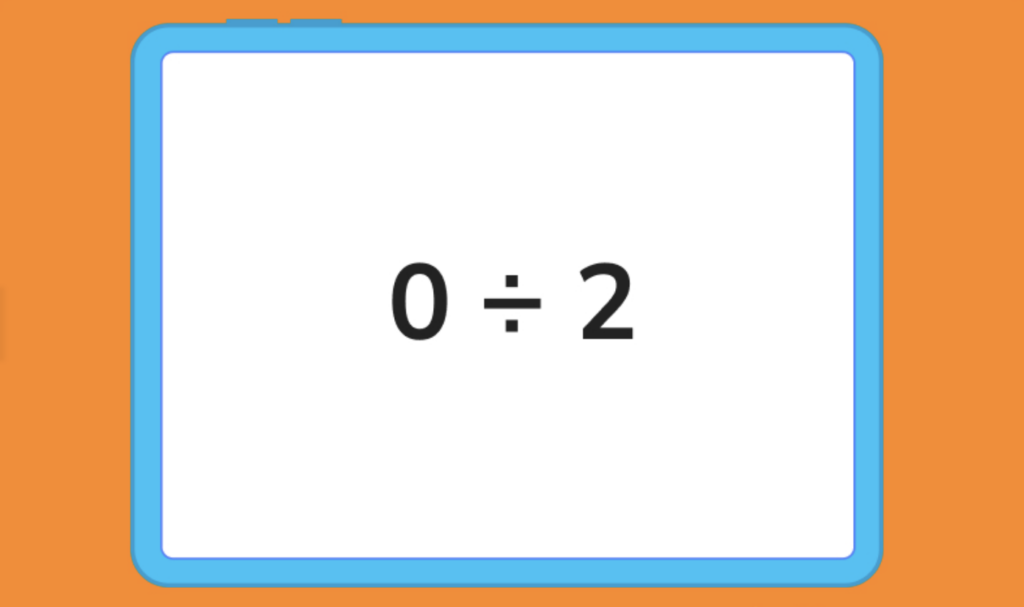
Ready to give it a go?
You’ve done great so far — and you’re well on your way to mastering the art of division. Don’t be afraid to keep trying and make mistakes.
Practice makes perfect, so we’ve given you a few more problems to practice as you work to perfect your skills. Remember: you can always scroll up to walk through the tutorials and refresh yourself on the terms, placement and properties you’ll need to solve these correctly.
By the end of this session, we’re confident that you’ll be ready to claim that A+ on your next maths test. You can do it!
Question 1: what is 4 ÷ 2?
Question 2: what is 14 ÷ 8?
Question 3: what is 20 ÷ 5?
The answer is 2.
How did we get here?
The answer is 1R6.
How did we get here?
The answer is 4.
How did we get here?
Sign up for the DoodleMaths app today!
Turn math into an adventure when you sign up for DoodleMaths.
Division is the mathematical process that breaks down a big value into smaller values.
There are plenty of times you’ll use division in your everyday life. Some of the most common ways might be to break up an even quantity of something, determining how much of an ingredient to use or grouping up items for use.
Division is the inverse of multiplication. This means that it naturally undoes any sort of operation that’s done with multiplication.
The three main parts of division are the divisor, dividend and quotient.

Rational vs irrational numbers
Learn about the differences between rational and irrational numbers
Roman numerals from 1 to 100
Learn the Roman numerals from 1 to 100 and have a go at some questions!
Lesson credits

Christina Levandowski
Christina has written for hundreds of clients from small businesses to Indeed.com. She has extensive experience working with marketing strategy and social media marketing, and has her own business creating assets for clients in the space.

Jill Padfield
Jill Padfield has 7 years of experience teaching mathematics. She is currently working as a Business Analyst, working to improve services for Veterans while earning a masters degree in business administration.

Christina Levandowski
Christina has written for hundreds of clients from small businesses to Indeed.com. She has extensive experience working with marketing strategy and social media marketing, and has her own business creating assets for clients in the space. She enjoys being an entrepreneur and has also started pursuing investment opportunities as time permits.

Jill Padfield
Jill Padfield has 7 years of experience teaching high school mathematics, ranging from Alegra 1 to AP Calculas. She is currently working as a Business Analyst, working to improve services for Veterans while earning a masters degree in business administration.
Book a chat with our team
If you’d like to use Doodle’s browser version, please visit this page on a desktop.
To log in to Doodle on this device, you can do so through our apps. You can find out how to download them here: